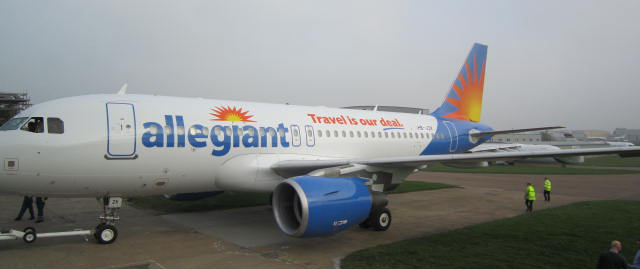
Allegiant’s first Airbus A319 (HB-JZK / N301NV) after being painted to their livery. Image from Allegiant.
Earlier this year, Allegiant Air announced that they would be adding 19 Airbus A319s into their fleet. The one seen in this story was recently painted in United Kingdom Southend (SEN) and previously wore EasyJet colors. It currently shows registration number HB-JZK, but when put into service, this aircraft will most likely be wearing N301NV.
Their first A319 is scheduled to be delivered Q1 2013 and in operations Q2 2013. After it is delivered, the aircraft will be used for crew training.
BONUS: READ MORE ABOUT ALLEGIANT’S AIRBUS A319
Allegiant is configuring their A319’s in a high-density, 156 economy seat layout. The double exit doors over the wing shows that this aircraft is able to handle the 156 configuration (most A319’s with a single exit hold 134 seats).
One thing you might notice in all the photos is it doesn’t include the nose cone. I expect that is because the aircraft does not currently have a nose cone as seen on Skyliner-aviation.de. I am quite confident that it will have one soon.
I have to say that I love Allegiant’s livery. I think it looks best on the Boeing 757 and it is a bit squashed on the A319, but still looks slick.
Thanks Ken for the heads up!
ADDITIONAL ALLEGIANT A319 PHOTOS:
[nggallery id=27]
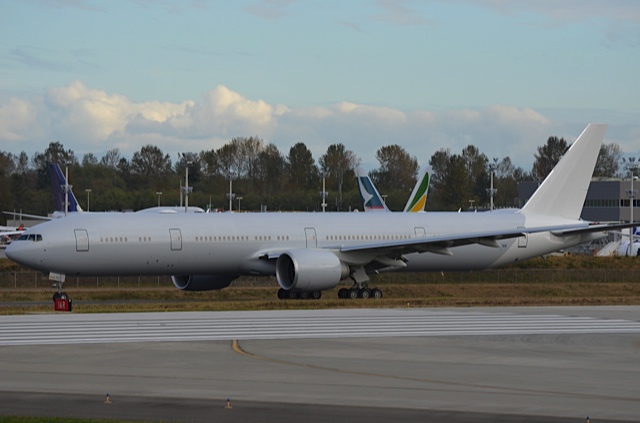
American Airline’s first Boeing 777-300ER (N717AN) is showing signs of their new livery. Photo by James Hackney.
American Airline’s first Boeing 777-300ER (N717AN) has shown up at Paine Field, and not many were expecting to see a gray body with a white tail. Where is the polished aluminum? Is this a special livery for the 300ER or is this American moving to a completely new design? It looks like that they are in the process of updating their livery.
“It’s no secret by now that AA will be taking delivery of new fleet types in the coming months/years, and that includes composite aircraft,”Andrea Huguely AA spokesperson told AirlineReporter.com. “Obviously those aircraft cannot be the polished aluminum that AA currently has, so additional paint will be inevitable.”
Based on the design on the 300ER, it doesn’t look like American is just looking to paint the aluminum areas gray, as they did with their original Airbus A300’s, but they are working towards a new design. On the 777, it doesn’t matter as much, but with the Boeing 787, the fuselage is not made out of aluminum, which is forcing American to re-think their design.
At this point the airline is not hinting what the new livery will look like, but it appears the tail will be white, with a gray fuselage (yes, I am that good at being an investigative journalist). I welcome the new livery with open arms, since I have not been a fan of American’s current livery, for quite sometime — but I know many of you disagree with me. American has already announced big changes with their future interiors and I am hoping their new livery will be equally impressive.

A possible mock-up of the new American Airline’s livery done by Anthony Harding.
UPDATED: Above is a mock up of what American’s new livery might look like done by Anthony Harding. From his website:
“I wanted to see if I could create an effective evolution of the current brand. I wanted a bold new look for American Airlines, one that looks classy, distinguished, and ultra-modern with highly geometric, sharp angles and a metallic feel that creates a sense of strength and security. I evolved the Scissor Eagle logo to a more abstract form. The new ’œEagle’ is not just an abstract eagle, but also an abstract representation of the American flag. The overall brand beyond the livery would take heavy influence from timeless Art Deco, Gothic and neo-Art Deco design which symbolizes American strength, freedom, and an overall classicism that distinguishes the brand from the competition.”
Sure, there are many potential designs that people have put up on the internet, but I have to say this is my favorite. Clean, crisp and with connections to the history of the airline.
A HUGE thanks to James Hackney (@jameshackney01) for taking the amazing 777-300ER photos of American’s 777-300ER at Paine Field and to Anthony Harding for letting me use his mock up.
[nggallery id=26]

The government of Kuwait will take delivery of this BBJ 7478.
This Saturday was a nice enough day to head up to Paine Field to check out what was going on. I heard that the State of Kuwait’s BBJ 7478 would be high-speed ground testing and I also wanted to track down American Airlines first 777-300ER — I wasn’t disappointed.
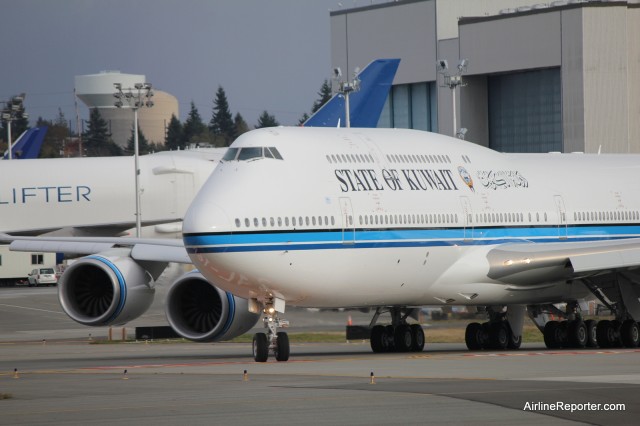
The livery for the State of Kuwait aircraft is very similar to Kuwait Airway’s design.
The State of Kuwait’s BBJ 7478 used to have a different look — it was the first Boeing 747-8 Intercontinental that sported the orange sunrise livery (N6067E) and was recently re-painted.
The first BBJ 7478 was delivered to the government of Qatar in February 2012, even though Boeing and the Qatari government still has not confirmed that to date.
It is bit more obvious what customer will take delivery of 9K-GAA. Even though the government of Kuwait is willing to put their livery on the aircraft before delivery, they aren’t quite ready to give details on how their aircraft will be configured.
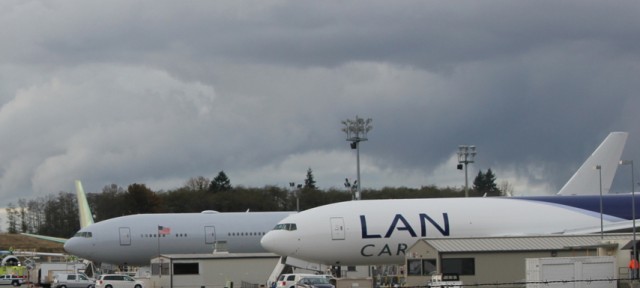
American Airline’s first Boeing 777-300ER will have a special livery.
Paine Field has quite a few Boeing aircraft sitting outside at any given time. The planes might be large, but it can be a challenge to track a particular aircraft down and Boeing does not go out of their way to park aircraft to make them easy to spot.
After some time I was able to track down American Airline’s first 777-300ER. What makes this aircraft special is it is painted gray. American is known for having a bare metal livery and is this just a special livery to celebrate the aircraft type or will this be the airline’s new livery? (stay tuned, I am working to find out more about this).
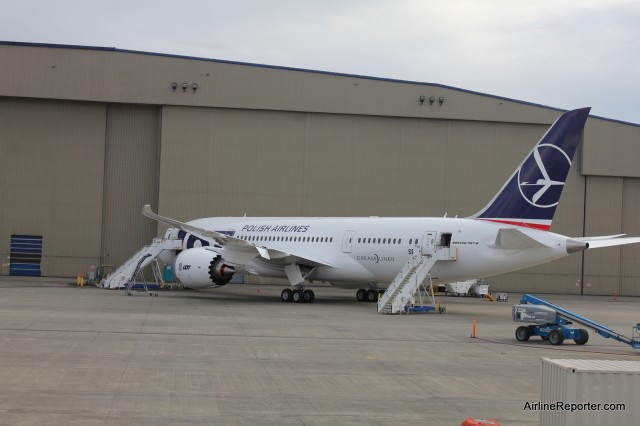
LOT’s first Boeing 787 Dreamliner is looking good.
There are plenty of 787’s sitting around waiting for different parts before delivery, but LOT’s Dreamliner is getting closer to delivery, which is expected soon. The new livery is simplistic, but it works and looks better in person than it does in photos.
BONUS: See an interior mock-up of LOT’s Dreamliner

A special Beijing livery on an Air China Boeing 777-300ER (B-2035). You can see the State of Kuwait BBJ 7478.
A last treat before heading back home was seeing this special Beijing livery for an Air China Boeing 777-300ER.
There were a few other odds and ends you can take a look at my Flickr profile. I have to say that I love living in Seattle.
http://www.flickr.com/photos/airlinereporter/sets/72157631815727815/detail/

HI-RES IMAGE (click for larger). Air Pacific’s new livery and name (Fiji Airways) seen on an Airbus A330. Image from Fiji Airways.
Air Pacific, the national airline of Fiji, is not doing too shabby. During the financial year 2011/2012, they recorded their highest revenue ever of $362.4 million and it is time for the airline to start spending that money.
Not only is the airline changing their look and ordering new aircraft, they are totally revamping their brand and changing their name to Fiji Airways. The name is not new, it was what the airline was called from 1951 to 1970 before changing to Air Pacific.
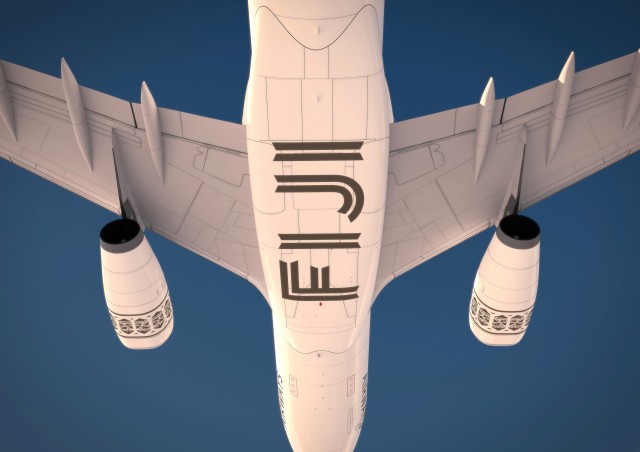
HI-RES IMAGE (click for larger). Underbelly and engine cowling design of Fiji Airway’s Airbus A330. Image from Fiji Airways.
The airline will take delivery of three brand new Airbus A330 aircraft in 2013 (one in March, one in May and the final in November), which will show off their new Fiji Airways livery. The A330s will be used to replace Air Pacific’s Boeing 747-400’s.
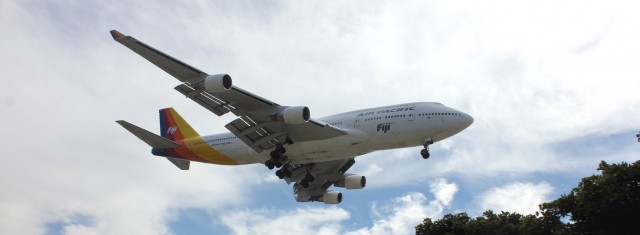
Air Pacific / Fiji Airways will phase out their Boeing 747-400’s. This shows their current livery. Image by AirlineReporter.com
From the company’s press release: “To help evoke its classic heritage as the national carrier of Fiji, the new Fiji Airways brandmark is a new Masi symbol designed by a renowned Fijian Masi artist, Makereta Matemosi. Masi is a traditional local art form that has been a respected part of Fijian culture for several centuries. The distinctive Masi symbol is a Teteva motif; symbolizing the airline, its values and the spirit of Fiji. The Teteva will also represent the connection that Fiji Airways will offer between the country’s 333 islands and the rest of the world.”
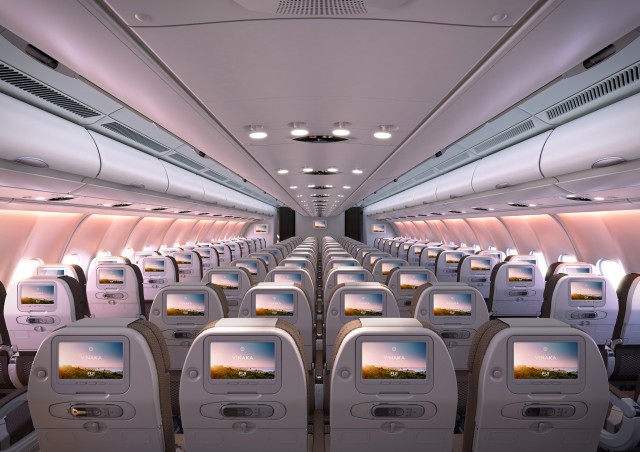
HI-RES IMAGE (click for larger). Fiji Airway’s new economy interior. Image from Fiji Airways.
’œThe unveiling of the new look and features of our soon-to-arrive A330s is the latest milestone in a series of initiatives that are a part of the Air Pacific’s restructuring and rebranding,’ said Dave Pflieger, Air Pacific’s Managing Director and CEO. “We have made significant progress with our turnaround plan during the last 30 months, and have taken great strides to ensure everyone who steps aboard Fiji Airways in 2013 will be able to start their holiday when they step aboard. Service and comfort are top priorities, and these state-of-the-art aircraft promise the best of both worlds.”
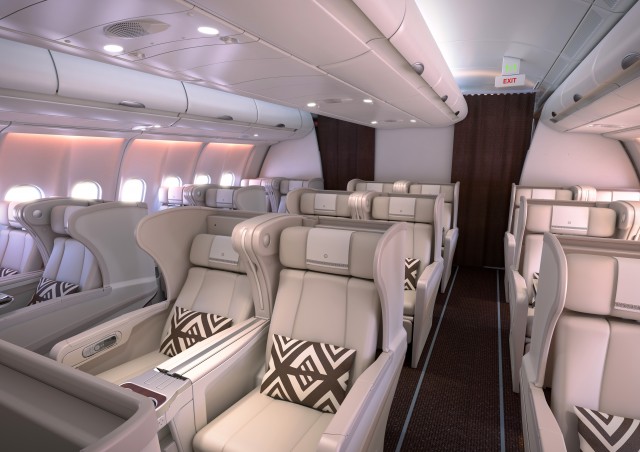
HI-RES Image (click for larger). Fiji Airway’s new business class product is by Zodiac Aerospace/Weber. Image from Fiji Airways.
Fiji Airways will offer a new interior product as well, featuring the Panasonic eX2 IFEC in-flight entertainment (IFE) option. This is the same system that I was able to try out on LAN’s first Boeing 787 Dreamliner and let me tell you it is slick.
The 249 economy seats on-board will offer a 7.5″ recline, 9″ IFE screens and access to power outlets and USB connections. The 24 business class will have a 60″ pitch, a bed length of 76″ and a 15.4″ IFE screen. Unfortunately, the business class seats do not fully recline, but quite close with a 8 degree angle.
MORE FIJI AIRWAYS PHOTOS:
[nggallery id=25]
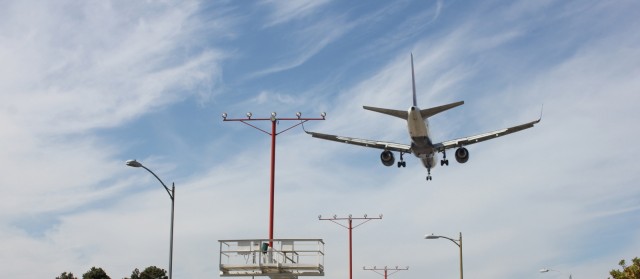
Are photos like these illegal? – depends on who you ask.
Phil Derner, owner of NYCAviation.com, posted a very important story about plane spotters and law enforcement today that I wanted to share.
I personally feel lucky that I have never been stopped by law enforcement while taking photos of aircraft, but it is always on my mind. People should be able to take photos of airplanes without being harassed, but unfortunately, that is not always the case. It is important to report suspicious people, but it is not okay to harass AvGeeks taking photos. READ THE FULL STORY…













